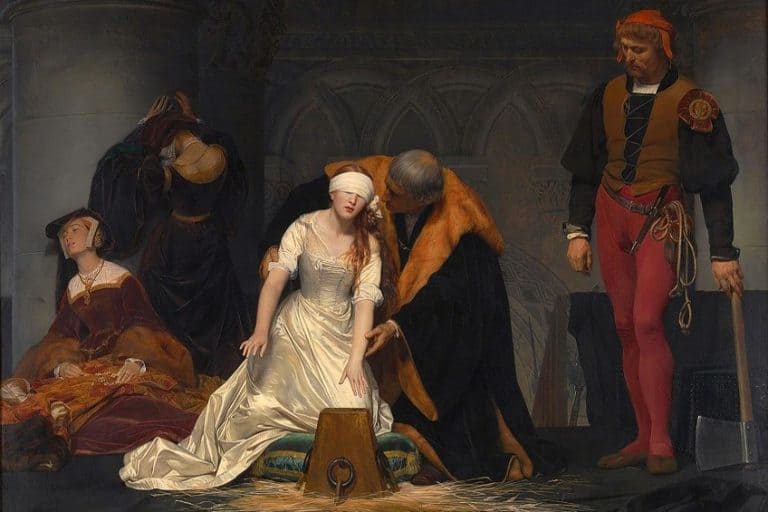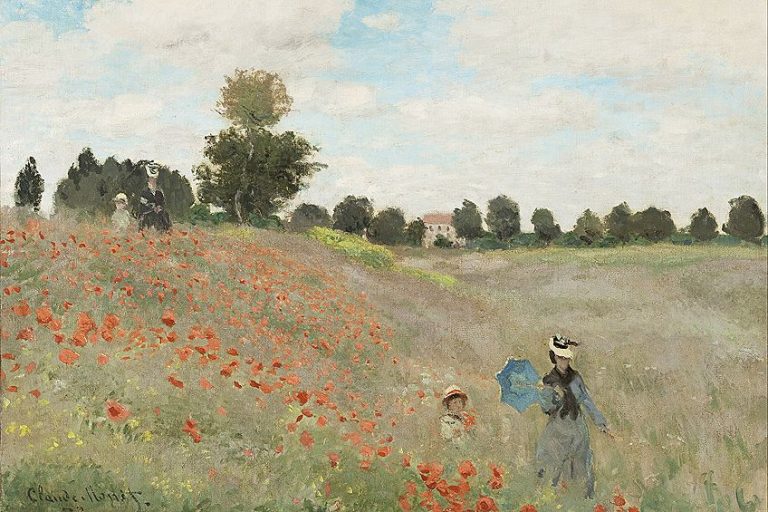“Girl With a Pearl Earring” Painting – Vermeer’s Iconic Tronie
Today, we will be looking at the famous painting of a woman known as the Girl with a Pearl Earring (1665) painting. The lady with a pearl earring painting was known by several names over the ages until being given its current title at the end of the 20th century. This article will cover the Girl with a Pearl Earring analysis and description.
Table of Contents
A Study of The Girl with a Pearl Earring (c. 1665) Painting
| Date Completed | c. 1665 |
| Medium | Oil on canvas |
| Dimensions | 44 cm x 39 cm |
| Current Location | Mauritshuis, the Hague |
The famous painting of a woman with an earring has been in the Hague’s collection since around 1902 and has been the focus of several literary and film adaptations. It portrays a European female sporting a strange outfit, an eastern headdress, and what looks to be a giant pearl earring.
But who painted the girl with the pearl earring painting?
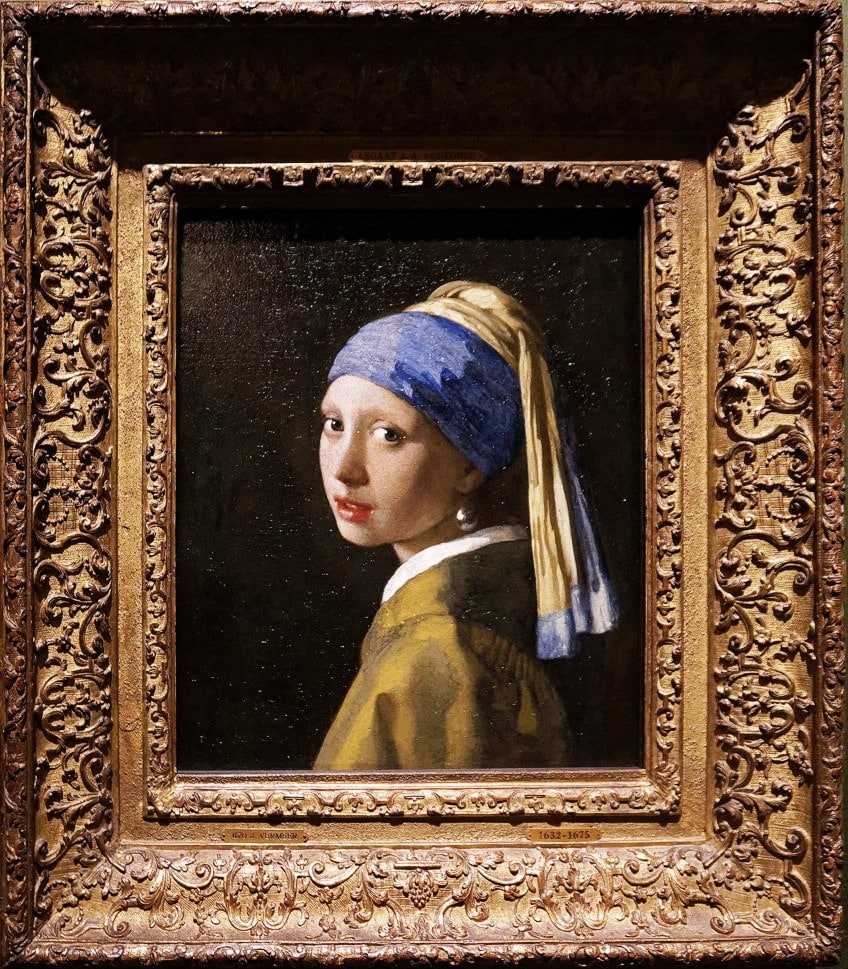
Johannes Vermeer: The Artist
| Nationality | Dutch |
| Date of Birth | October 1632 |
| Date of Death | December 1675 |
| Place of Birth | Delft, Netherlands |
Reconstructing Vermeer’s paintings with any degree of accuracy is a difficult task. What we currently know about 17th-century Dutch painting processes is primarily dependent on information obtained from contemporaneous painting books and modern scientific analyses. Painting guides from the time period tended to focus on theoretic rather than practical aspects of the noble art of painting.
Despite the fact that fundamental procedures were periodically specified and formulas for certain palettes were provided, the true technique of painting was passed down from masters to new painters through years of apprenticeship. There are few historical recordings of studio practice.

Despite the fact that Vermeer experimented endlessly with approaches to create the appearance of three-dimensional space and represent the impact of natural light, research suggests that he worked mostly within the confines of Northern European painters’ traditional studio methods.
These techniques were significantly different from what painters use now.
Modern artists frequently create a cohesive whole with their work. They function while standing so that they can stroll back and see the entire project. On a white canvas, the picture is created entirely in full color. Palettes normally contain all of the pigments that will be used in the final piece. Experimentation is quite important. The technique is no longer taught in art schools since it is no longer considered essential to the artistic effort.
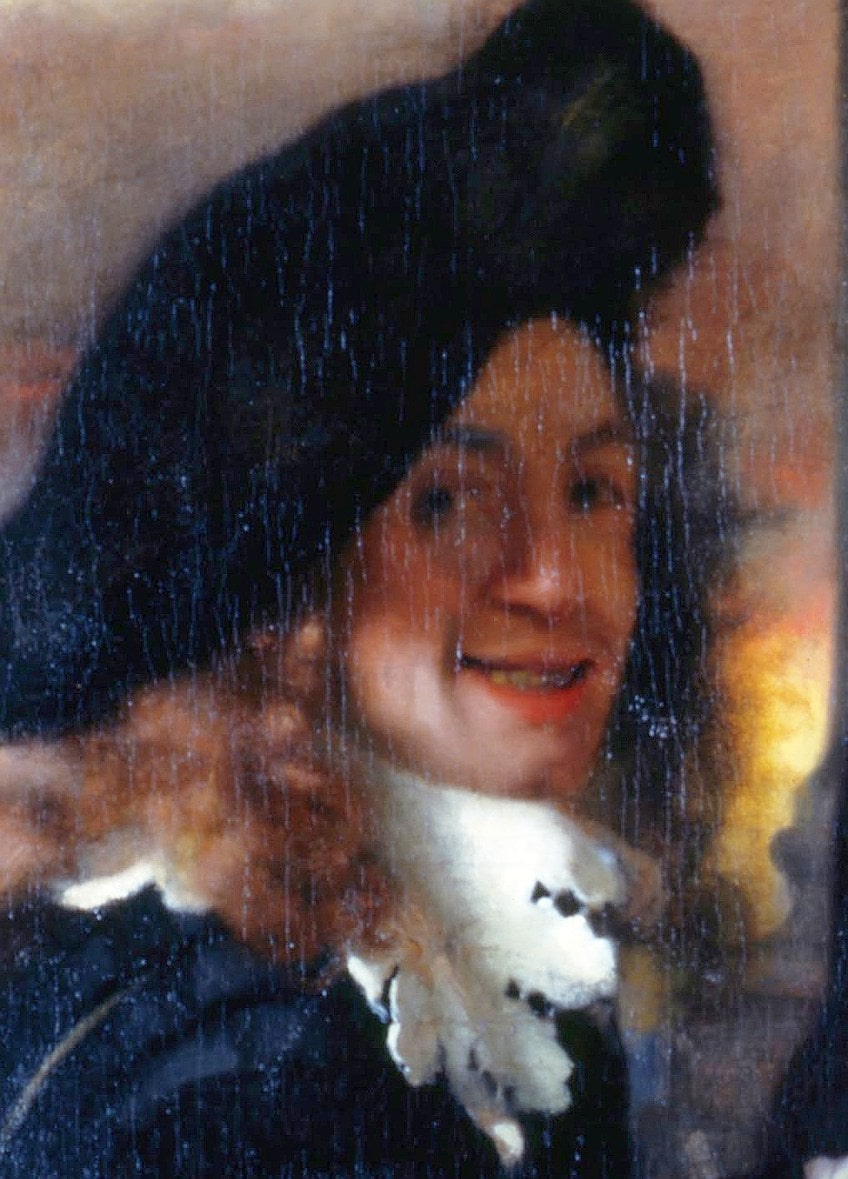
Vermeer’s historical paintings, which are difficult to reconcile with his later works in many ways, gave him a range of vision and execution that no other genre painter of the time had. Thickly applied impasto paint is prevalent in these pieces. His color was also striking, but the lighting was more traditional. The obvious build-up of paint provides a thick and uneven surface that emphasizes the figures’ material existence, despite continuous overpainting indicating technical doubt. The majority of the later interiors are substantially smaller than these older historical paintings.
Although Vermeer owes the great painters a thematic and compositional debt, his portrayal never approaches the same degree of microscopic precision for which their work had become famous across Europe.

Girl with a Pearl Earring Analysis
On the basis of the specular reflection, the pear form, and the great size of the earring, a Dutch astrophysicist questioned the substance of the earring, arguing that it seems more like refined tin than pearl.
Since the artwork’s most recent renovation in 1994, the exquisite color scheme and proximity of the girl’s look toward the spectator have been significantly heightened.
The black background was formerly a brilliant enamel green, which was found during the repair and is now slightly uneven. Though appearing insignificant, the figure’s cream-colored complexion and transparent eyes, which are riveted on the spectator, are nicely contrasted by the harsh and flat background. To get this look, a thin transparent paint glaze was put over the black backdrop. Nevertheless, the indigo and weld organic pigments in the green glaze have vanished.
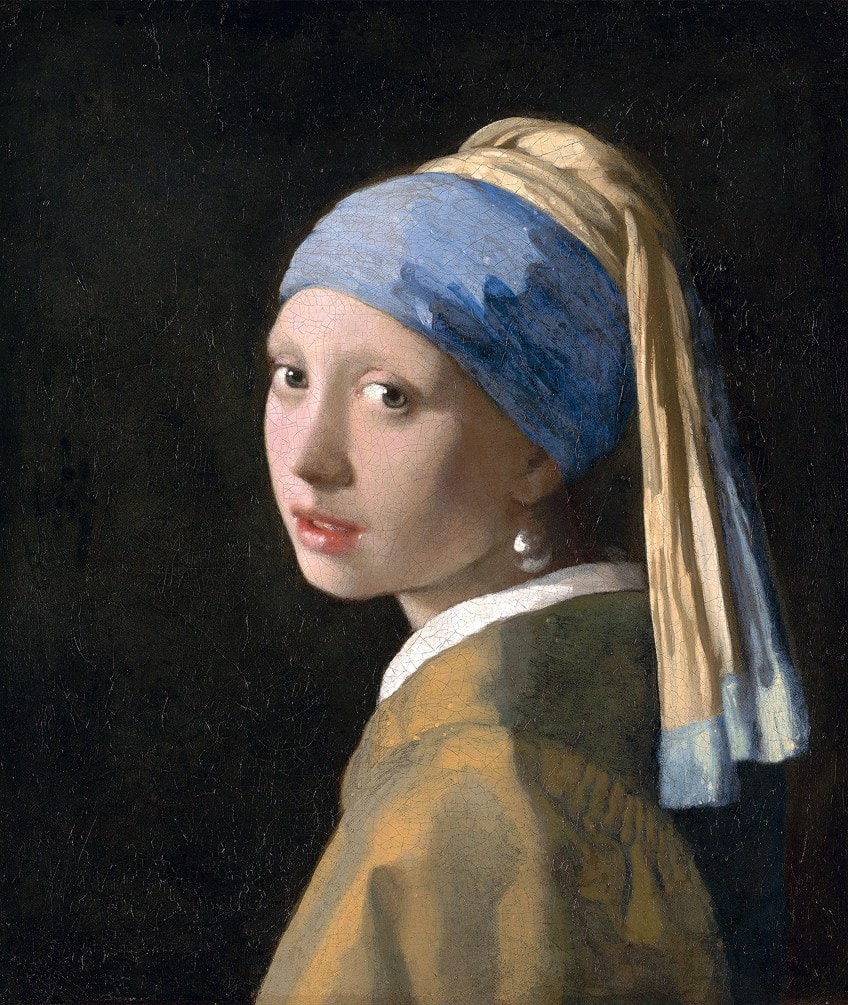
While this representation appears to have the features of a portrait on the face, it is really known as a tronie. A tronie is a study portrait of a figure that was prominent during the Dutch Golden Age. Artists frequently choose to depict these characters in “exotic” clothing in order to demonstrate their superior painting talents by recreating luxurious fabric.
The lady with a pearl earring artwork is a real tronie since it does not portray a specific individual. Instead, it depicts an unknown young woman dressed opulently who, like an apparition emerges from the darkness.

Display and Ownership
Arnoldus Andries des Tombe bought the artwork in The Hague at an auction in 1881 on the advice of Victor de Stuers, who had spent several years trying to prevent foreign interests from acquiring Vermeer’s most valuable artworks. At that time, it was in terrible shape. Des Tombe died without descendants in 1902, leaving the Mauritshuis with this and other pieces.
The artwork was presented at Washington DC’s National Gallery of Art in 1966 as well as in 1996 as part of one of Vermeer’s exhibits.
Painting Technique
Scientists from the Netherlands Institute analyzed the artwork. The ground is comprised of lead white, chalk, ochre, and very little black and is thick and yellowish in color. Bone black, chalk, weld, minor traces of indigo, and red ochre make up the painting’s dark backdrop. Natural ultramarine, ochres, bone black, and lead white were used to paint the face and drapery. In March 2018, a worldwide team of art specialists studied the artwork for two weeks in a specially created glass studio in the museum, which was accessible to the public for viewing.
To understand more about Vermeer’s procedures and components, researchers removed the artwork from its frame and studied it using microscopes, X-ray equipment, and a sophisticated scanner. Abbie Vandivere led the investigation, and the results were published by Mauritshuis. Vandivere’s blog offers several facts about the project. The existence of fine eyelashes, a green curtain behind the head, the alterations done, the pigments employed, and where they came from were among the findings.
The absence of brows and the featureless backdrop led to conjecture that Vermeer was painting an idealized or abstract face; nevertheless, later findings revealed that he was painting a genuine person in a real environment.
Vermeer is noted for his use of light rather than line to create curves and shapes. The model’s face, which Vermeer drew in planes of light and shadow, exemplifies this peculiar modeling style. Vermeer used a rigorous four-step approach prevalent among 17th-century artists to attain this style. He’d start by “inventing,” or making an initial drawing on the canvas.
Then, using a technique known as dead-coloring, he created a monochrome underpainting.
He then applied some color. Finally, he did apply a small layer of glaze to particular portions of the picture in order to make it extremely bright. He glazed two portions of the artwork, according to a subsequent restoration: the entire backdrop, which was initially an opalescent green, as well as the blue portion of her headdress.
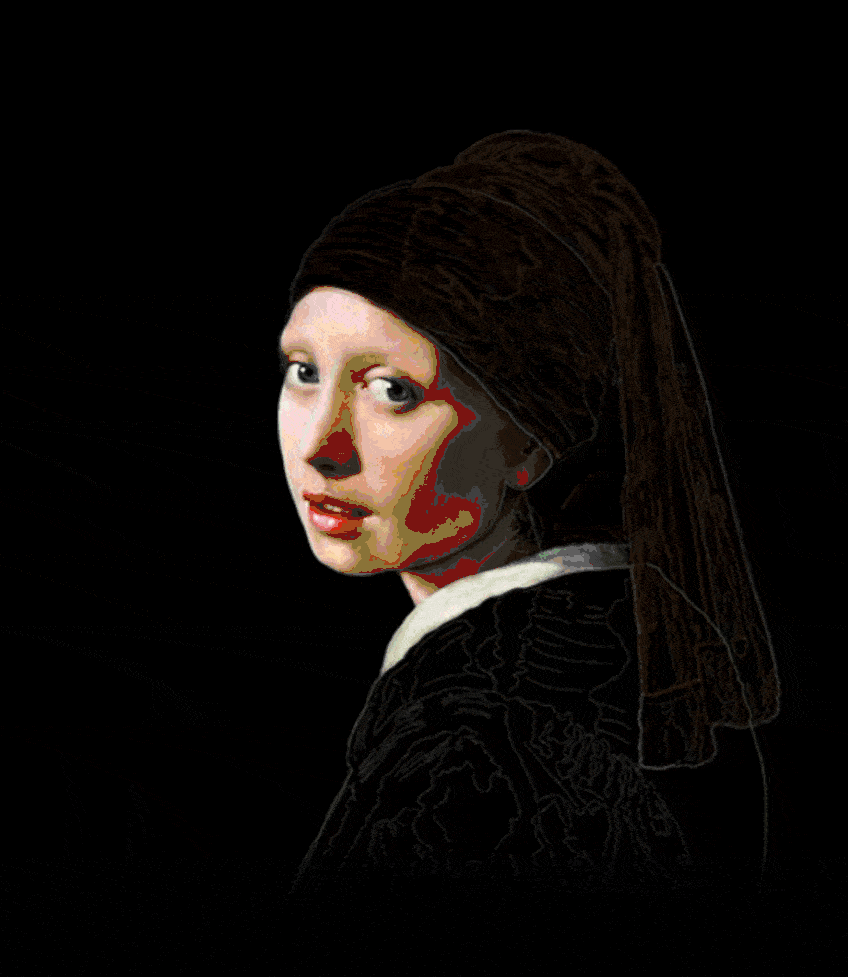
Painting Title
Over the years, the picture has been known by numerous names in various nations. It might have been one of the two tronies created in the Turkish style that was registered in Vermeer’s collection at the time of his death. It might have been the picture described as a “Portrait in Antique Costume, exceptionally artistic” in the catalog of a 1696 painting auction in Amsterdam.
The picture was renamed Girl with a Turban after its transfer to the Mauritshuis, and it was noted in the 1675 catalog that the headdress had become a fashion item of considerable intrigue during the period of European conflicts against the Turks. By 1995, it was thought that the title Lady with a Pearl Earring was more fitting.
Pearls appear in 21 of Vermeer’s paintings, the most renowned of which being the famous painting of a woman with a pearl necklace.
In 20th-century fakes that were temporarily claimed to Vermeer, similarly shaped ear-pieces were employed as plausible accessories. The artwork’s English title was usually just Head of a Young Girl; however, it was also known as The Pearl. One reviewer said that the moniker was given because the person shines with an inner brightness against the black backdrop, not merely because of the earring detailing.
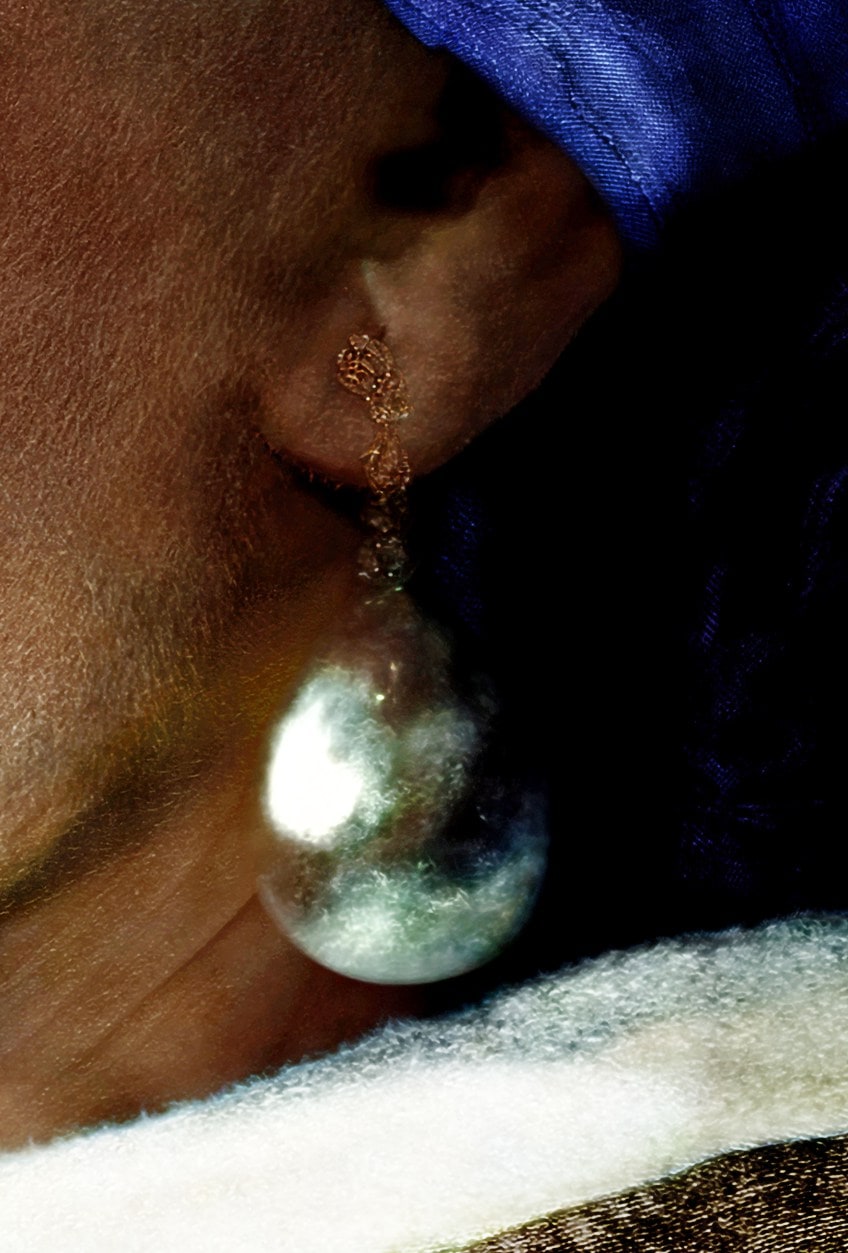
Cultural Impact
Poems were among the first literary adaptations of the picture. It is an opportunity for Yann Lovelock to investigate the relationship between imagined beauty translated into paint and lived experience. Marilyn Chandler McEntyre commented on the child’s quiet, self-possessed demeanor, while W. S. Di Piero envisioned how the girl may seem in the present surroundings of Haight Street in San Francisco.
It is the title of Marta Morazzoni’s compilation of short stories which were set in the Baroque period. According to the title narrative, a Dutch art collector sold Vermeer’s picture to an unusual Dane in 1658. The two males can only react to the idealized version of the feminine in art because they are apathetic to women in real life.
Tracy Chevalier’s historical book set a decade later dramatized the circumstances behind the artwork’s production.
Here, Vermeer has a strong relationship with a servant whom he employs as an assistant and has modeled for him while donning his wife’s earrings. The book was also turned into a movie with the same name in 2003 as well as a play in 2008. The picture was also included in the 2007 film St Trinian’s, in which a bunch of rowdy schoolgirls steal it in order to generate money for their school.
Fellow painters made legendary use of Vermeer’s picture at the time.
As a remark on the paucity of black people in museums and galleries, Ethiopian American Awol Erizku remade it as a print in 2009, highlighting a young black lady and replacing the pearl earrings with bamboo earrings. Girl with a Bamboo Earring is the title of his composition. In 2014, English graffiti artist Banksy recreated the picture as a mural in Bristol, replacing the pearl earring with an alert box.
Many people still regard it as one of the most renowned paintings in the world today. The painting is appreciated for the enigma that surrounds it, in addition to its unique setting and enticing aesthetics. There’s nothing between her and us — it’s right there. She has this unique capacity of being both open and enigmatic at the same time, which is what draws people to her.

The Dutch Golden Age was an exciting period of artistic splendor in the Netherlands throughout the 17th century. Enlightened painters drew inspiration from Northern Renaissance painting styles throughout this period, resulting in classics like Johannes Vermeer’s “Girl With a Pearl Earring” painting. Despite its mystique, the lady with a pearl earring painting has become one of history’s most admired works.
Take a look at our Girl with a Pearl Earring webstory here!
Frequently Asked Questions
Who Painted The Girl with the Pearl Earring Painting?
Johannes Vermeer made the iconic painting. He was well-known for his particular artistic approach to painting. Despite the fact that Vermeer tried constantly varying ways to convey the effect of natural light and create the illusion of three-dimensional space, research reveals that he largely worked within the limits of Northern European artists’ traditional studio methods. These methods were vastly different from those used now by artists. With their work, modern artists usually create a unified whole. They work while standing in order to walk back and observe the full job.
What Impact Did the Famous Painting of a Woman With an Earring Have?
It is still regarded as one of the most renowned and famous works of art in the world today. In addition to its unusual setting and alluring aesthetic, the sculpture is admired for the mystique that surrounds it. Nothing separates her from us; it’s right there. People are drawn to her because of her rare ability to be both open and enigmatic at the same time. The iconic picture of a woman with an earring, which has been the subject of countless literary and film adaptations, has been in the Hague’s collection since approximately 1902.
Alicia du Plessis is a multidisciplinary writer. She completed her Bachelor of Arts degree, majoring in Art History and Classical Civilization, as well as two Honors, namely, in Art History and Education and Development, at the University of KwaZulu-Natal, South Africa. For her main Honors project in Art History, she explored perceptions of the San Bushmen’s identity and the concept of the “Other”. She has also looked at the use of photography in art and how it has been used to portray people’s lives.
Alicia’s other areas of interest in Art History include the process of writing about Art History and how to analyze paintings. Some of her favorite art movements include Impressionism and German Expressionism. She is yet to complete her Masters in Art History (she would like to do this abroad in Europe) having given it some time to first develop more professional experience with the interest to one day lecture it too.
Alicia has been working for artincontext.com since 2021 as an author and art history expert. She has specialized in painting analysis and is covering most of our painting analysis.
Learn more about Alicia du Plessis and the Art in Context Team.
Cite this Article
Alicia, du Plessis, ““Girl With a Pearl Earring” Painting – Vermeer’s Iconic Tronie.” Art in Context. May 31, 2022. URL: https://artincontext.org/girl-with-a-pearl-earring-painting/
du Plessis, A. (2022, 31 May). “Girl With a Pearl Earring” Painting – Vermeer’s Iconic Tronie. Art in Context. https://artincontext.org/girl-with-a-pearl-earring-painting/
du Plessis, Alicia. ““Girl With a Pearl Earring” Painting – Vermeer’s Iconic Tronie.” Art in Context, May 31, 2022. https://artincontext.org/girl-with-a-pearl-earring-painting/.





